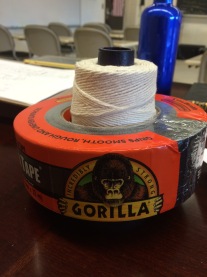Michael K. Milton ~ @42ThinkDeep

My favorite tools to prepare students for midterms is not an app or notecards (although both can absolutely be useful) but rather kitchen twine and Gorilla tape.
A few summers ago, I read Making Thinking Visible: How to promote Engagement, Understanding, and Independence for All Leaders which, I feel, leveled me up as a teacher. The crux of the book is that to help students develop their as critical thinkers, we must name and explain the types of thinking routines. [I can lend out my copy, but I have written all over it and as I reference it regularly I’d need it back.]
They provide great thinking exercises like See-Think-Wonder which I regularly use for paintings and images. First students write down what they see (and see only – you think that he’s hardworking, you see that his clothes are torn, he is swinging an ax, and there are a pile of broken rocks next to him). Then they write down what they think (example in the previous sentence). Finally, students write down what questions they have about the image, the artist, the time period…anything relating to it, really.
My favorite activity (which brings us to the aforementioned kitchen twine and Gorilla tape) is Generate-Sort-Connect-Elaborate. Here is a breakdown of how this exercise typically works:
- Generate a list or words, ideas, and people associated with the topic
- On a chart, put main topic in the middle of the board/paper
- Have students sort the information (more important information goes to the middle)
- Have students make connections between the different ideas by drawing lines and briefly explaining the connection on the lines
- Have students to pick a few central ideas and elaborate on those.
- Share the thinking with a group or with the class.
I’ve used this in in the past to help prepare students for debates or writing essays. But I also modified it help students prepare for larger exams.
With this activity, I write the names of the different units on the whiteboards (and windows) around my classroom. Then students rotate around the room filling in the terms and explaining or defining the words associated with the unit. When the boards are sufficiently filled, students work to make connections between the terms within the units. Students literally are using the whiteboard markers to link the terms. On the lines of the connections, students write down how they are connected.

This is my classroom before the 60 inch TV was installed. On this board, my World History students were making connections for the Industrial Revolution.
After a few rounds of this, I introduce the kitchen string and Gorilla tape and let students make connections between the units. Students (typically working with small groups at this point), cut the string and tape them from one whiteboard/window to another. This helps to get students to realize that events in history did not simply happen, but are often the cause of a movement or event that happened before. In the middle of the connection, students tape a piece of paper with their thinking behind the connection. For instance, students often draw connections between the absolute monarchs and the Enlightenment (which makes sense as the Enlightenment is a response to the absolute monarchs).

While you may have to look closely, there is strong criss-crossing my classroom.
Sometimes the connections are not a direct result of one another, but they are related. For instance, last year a student connected Voltaire with the Edict of Nantes as Voltaire was for the freedom of religion and the Edict of Nantes was signed by Henry IV of France to allow the Huguenots to practice their religion in Catholic France. At the end we carefully walk around the classroom to read the connections that students have made. (Students also take pictures are we collaborated on a really neat study guide.)
While in the end my classroom is a bit of a mess and looks like my students and I are conspiracy theorists as depicted in television and movies, it absolutely shows the thinking that my students did to help prepare for their exams.
No comments:
Post a Comment